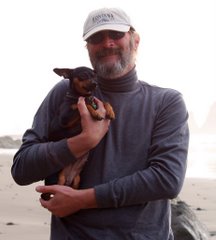And the wavin' wheat can sure smell sweet
When the wind comes right behind the rain!
--Rogers and Hammerstein
Click here to hear Hugh Jackman (yes!) and the Royal National sing the title song from Rogers and Hammerstein's epic musical.
Originally I thought of opening this section with George Strait's song Amarillo by Morning, but the lyrics for that song were even less appropriate than the Green Green Grass of Home which I used for Day Two. I did reach Amarillo before noon, but I started the day in Santa Rosa, New Mexico where I had taken refuge from the storm the night before. As any of my long-time readers know, one of my favorite subjects for photography is a governmental building. Santa Rosa is the seat of Guadalupe County, so after a quick breakfast at the motel, I headed out in search of this fine red sandstone structure. I haven't been posting my courthouses, and as today's drive didn't end up with much in the way of landscape photography, here's the first shot of the day.
The Guadalupe County Courthouse, Santa Rosa, New Mexico
My gas price app suggested that gas would be cheaper in Tucumcari, sixty miles ahead, so I waited to fill up there. The clouds were still hanging heavy in the sky, but no rain fell as I drove eastward on I-40. Taking the exit for Tucumcari, I soon found a station where, indeed, the gas was considerably less expensive than in Santa Rosa.
Tucumcari is the seat of Quay County, named for a Senator from Pennsylvania who supported statehood for New Mexico. It is shaped like a staircase and is unusual among government units in that it borders seven other New Mexico counties and three Texas counties. Of course I had to photograph the courthouse, a much more modern looking building than the one in Santa Rosa, but still classic in design. Tucumcari is also proud of its association with historic Route 66, and as I drove through town I saw several beautifully restored cars from the 1950s parked on display in front of many different businesses.
East of town, I saw a collection of older, unrestored cars stored behind a chain-link fence. Taking the next exit, I doubled back so that I could photograph this Studebaker Graveyard, as I took to calling the place. I counted at least thirteen Studebakers, most of them Larks, but also a 1930s Ford, a late 30s or early 40s Nash, a Hudson, and several other cars left to rot amidst all the Studebakers. The cars were guarded though, and not just by the chain link fence. Two dogs roamed the interior of the yard, and both dogs decided that I just wasn't supposed to get close enough to the fence to shoot through it. While I clicked away from a safe distance, another dog approached from my side of the fence. That was when I decided to climb back in the Saab and continue on down the road. And I love dogs. What can I say.
The Magnolia Oil Station
Vega, Texas
Crossing into Texas, I wanted to capture the "Welcome to Texas" sign, but was afraid I wouldn't be able to pull off the Interstate. Instead, I exited the highway with the intention of walking back to get the sign. Of course, once I had done that, I saw that there was a turnout situated just for people to take pictures of the sign. Oh well. As I drove along the on-ramp re-entering the highway, I saw one of those missed opportunities that so often come our way. I swear there was a highway sign on I-40 that actually read "Don't Mess with Texas." Short of slamming on my brakes and walking back up the on-ramp, I don't see how I could have photographed that sign. But I did take it's warning seriously. This is the state that loves to execute its prisoners, after all.
Vega, Texas is the seat of Oldham County, and once more, I took the break to grab some photos. Just across the street from the courthouse is a small two-story building that has been turned into a Route 66 museum. The Magnolia Oil Station was built prior to the commissioning of Route 66, and when "America's Main Street" came through town, it stood ready to serve the public. Magnolia Petroleum was a Texas based company that was in time purchased by Mobil.
It was getting close to noon as I neared Amarillo, but two more "attractions" caught my eye along the road. I thought the first was the legendary Cadillac Ranch, so I took the next exit and headed back the frontage road to check it out for myself. Indeed it was that particular site, but what I didn't know was that Ant Farm's collection of ten vintage Cadillacs has been turned into a graffiti paradise. Indeed a group of young women were there spraying words on the cars as I watched.
Ant Farm's Cadillac Ranch
Amarillo, Texas
And if Cadillac Ranch weren't enough to remind me that I am in Texas, just a little ways down the road was an RV park with three 1950s Cadillacs in decent shape on display out front.Of course I had to take pictures of them as well.
I considered grabbing the Potter County Courthouse in Amarillo, but the city was too large, and I was too hungry to search it out. Instead, on my way to a Thai Restaurant I read about using Yelp, I passed Mimi's Restaurant, and pulled into its empty parking lot. I would guess, given its location, that Mimi's doesn't get a lot of traffic, and indeed I was the only diner there at lunch time, but the food was good, and my server was adorable, and I would guess about 10 years old.
Having satisfied my stomach, I got back on I-40 and continued on across the Texas Panhandle crossing into Oklahoma mid-afternoon. Understand this. The whole reason for this roundabout itinerary was so that I could drive across Oklahoma. Prior to this trip, there were only two states west of the Mississippi I had never visited. Alaska wasn't quite close enough to Wichita to make it, but Oklahoma City is just over 125 miles south of Wichita, so why not. And besides, look at what wonders I've already seen on this trip.
I wasn't sure what to expect with Oklahoma. I was pretty sure that Curly and Laurie, and Ado Annie weren't going to meet me at the border singing and dancing up a storm. Two of my dear friends are natives of Oklahoma, and while I hadn't asked Roger for his suggestions, I did ask Bear. Bear's reply was that Oklahoma is such a red state that even the soil is red. He visits annually, or pretty close to annually, but he claims that his fear factor kicks up several notches as he gets close to the state line. As it turned out, I have no reason to doubt him, but I can't confirm his fears because I had no personal interactions whatsoever in the state. I drove straight along I-40 from the Texas line to Oklahoma City, stopped briefly to take some pictures at the State Capitol complex, then got on Interstate 35 and headed north to Wichita. I took no pictures of the rolling farm land I passed, and yes, the soil was a deep red. I spoke with no humans. I made no purchases. I just drove and shot buildings. I will note that directly in front of the capitol building is an oil derrick and a couple of tanks owned by Phillips Petroleum. I will also note that the sidewalk in front of the capitol is inlayed with stars, much like Hollywood Boulevard, except that these stars commemorate various events in the history (and even prehistory) of what is now Oklahoma. The one star I chose to photograph was the one commemorating the opening of a certain show on Broadway back in 1943: "The Play Oklahoma Opens on Broadway."
The Oklahoma State Capitol
Note the Phillips 66 derrick and tanks
Once across the Kansas line, I noted signs saying that exit 4 was the last "free exit." My maps had not warned me that I was headed down a toll road, but I decided to find out just what this was all about. I had been talking with John off and on all day, and he suggested the best way to get to his apartment once I reached Wichita. This involved leaving I-35 once I hit Kansas' largest city, and paying a $2.00 toll for the privilege. I was able to find John's place with no problem, and we set out to find a place that would be open for dinner, not just on a Monday, but on Labor Day. Eventually we ended up downtown at Wasabi where we both enjoyed fine Japanese cuisine, before calling it a night.
Total Miles Driven: 625 across four states.

















































